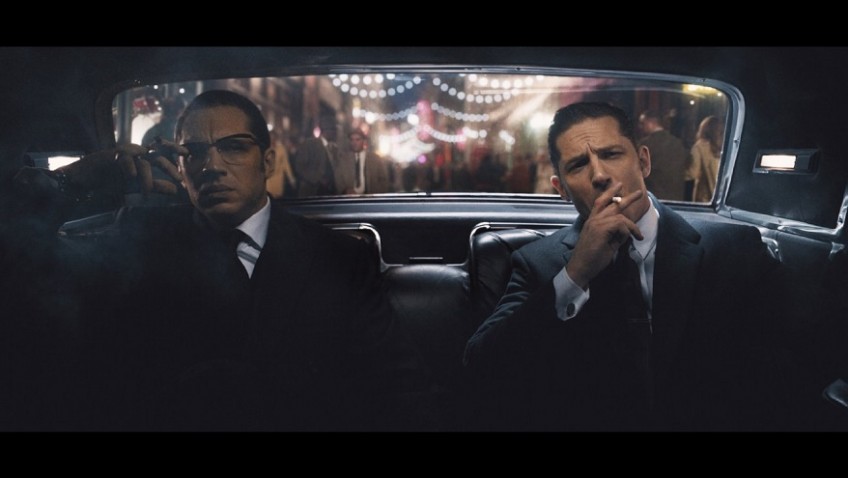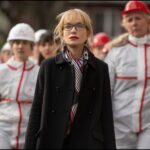Joyce Glasser reviews Legend
Even for those still fascinated by the East End gangsters who ran nightclubs as fronts for their criminal racketeering in the 1960s, The Kray Brothers’ story has been rehashed so frequently that you feel Legend has to be the definitive – and final– version. This is particularly the case when Director Brian Helgeland, who wrote the Oscar winning script for L.A. Confidential and Mystic River and turned his hand to directing a biopic with ‘42’, has adapted John Pearson’s book, The Profession of Violence: The Rise and Fall of the Kray Twins. Alas, Legend is anything but a definitive biopic. Instead, it is the promise of seeing the brilliant British actor Tom Hardy make cinema history by playing both Kray brothers that is the point of the film and box office draw. As is often the case with highly anticipated films with Academy Award written all over them, Legend, is unlikely to become the legend it hopes to become.
Starting with the title there is a lot that does not add up in Legend. Helgeland is an American who had never heard of the Krays until 1998, when he was 37. He was told a tall tale about their sadistic exploits that turned out to be a lie. Rather than being disappointed, this mythical story provided Helgeland with his route into the movie – and the title.
But casting aside the fact that the title was far better suited to Ridley Scott’s 1985 fantasy starring Tom Cruise, we have no indication from the last twenty minutes of the film that the word will become apt for the life and times of the two despicable brothers, last seen being locked away for years. And what Helgeland does not do is separate the fact from the legend.
Reggie’s first wife, Frances Shea (Emily Browning) narrates the film although she died at age 23 of what was probably an intentional drug overdose in 1967, 33 years before Reggie’s death. Her long courtship with Reggie, whom she met when she was 16, through her brother Frank (Colin Morgan), the Krays’ driver, is shown as being very romantic when it was, by most accounts, turbulent. What is not clear from the film is that the marriage was unofficially over after their honeymoon. Although the marriage lasted officially for two years, Frances could not possibly have witnessed what she narrates.
And what Frances does narrate is not in the voice of the bubbly, wild 1960s girl, aiming to be a secretary, who sunk into chronic depression after realising the man she loved was a hard-core, career criminal. Nor is it in the voice that Helgeland gives Emily Browning when she appears in the film. If you are going to make the romance between Reggie and Frances the core of the film, the bland Emily Brown is not the actress to pair up with Hardy. Can anyone find the seed of attraction, the spark of love or the chemistry between them?
There are some thrilling set pieces, with some lovely period detail from Tom Conroy; interesting costume design from Carline Harris and superb lighting from the superb Dick Pope (Mr Turner). They help add authenticity to the infamous murders of George Cornell (Shane Attwell) and Jack McCitie (Sam Spruell) and to the scandal that arose when Ron, whose homosexuality is, perhaps over-emphasised in the film, appears in a photo with a very gay Lord Boothby (wonderfully played by John Sessions). True to his L.A. Confidential roots, Helgeland also includes a truncated subplot about the Krays’ affiliation with the infamous American gangster Meyer Lansky. This is represented by a tense negotiating scene between the Krays and Lansky’s London rep, Angelo Bruno (an excellent Chazz Palminteri), but it is quickly forgotten.
What is lacking from the production design is the atmosphere of the 1960s and historic verisimilitude. The opening scene in the East End looks like a studio set design or, for that matter, like Coronation Street, and there’s nothing of the gritty, slimy streets still bearing witness to the war damage.
Nor is there any mention of the twins’ older brother or their father, both named Charles or of the armed robberies and hijackings that supplemented their protection rackets and profits from Esmeralda’s Barn. There are only two scenes with Violet Kray (Jane Wood) the chilling mother the twins worshipped, who believed that blood and graft could be washed away with a good cuppa. The argument here is that Helgeland wanted to focus on the tragic relationship of dependency and guilt between the brothers, a relationship that takes on a comic strip and romanticised veneer.
If any actor is capable of playing both brothers, it is Hardy, who not only bears some resemblance with make-up, but has a natural charisma which the Krays must have shared. But what he has been asked to do is to play two very different men, tied to one another by bonds that, in the film, must confound everyone but their (largely absent) mother. As Helgeland wants to portray Reggie as a would-be business genius whose career ambitions and marriage were sabotaged by his insane brother, Reggie is the film’s key character. Hardy’s portrayal of Reggie is so controlled, however, that we cannot always read his emotions. Not so with Ron, who is so out of control (everyone will be reminded of Hardy’s breakthrough performance in Nicolas Winding Refn’s Bronson) that you cannot believe he was the front man and key component to the Krays’ successful crime empire.
The technical accomplishment of putting both brothers together in a fight scene is quite a feat, and it takes a sharp eye to see the seams. But though Reggie did almost kill Ron in a fight, this long fight scene over Ron’s insulting remarks to Frances is dramatically redundant as there are plenty of scenes where we learn that Ron hated anyone who claimed Reggie’s attention. The point of the fight is that Ron almost died from his injury – which is not the case in the film.
As the film takes place in the 1960s, a director could have a field day appealing to the generation most likely to remember the Krays with the music from the Swinging Sixties. But the literal mindedness of Helgeland’s selection – The Chapel of Love when Frances and Reggie marry and In Crowd at nightclub scenes, The Look of Love when Frances and Reggie are together and even the 1925 Tea for Two for instance – is less than inspired.




